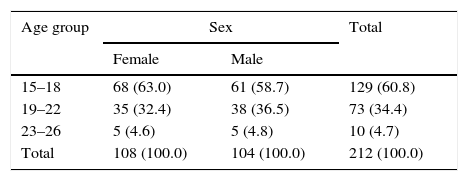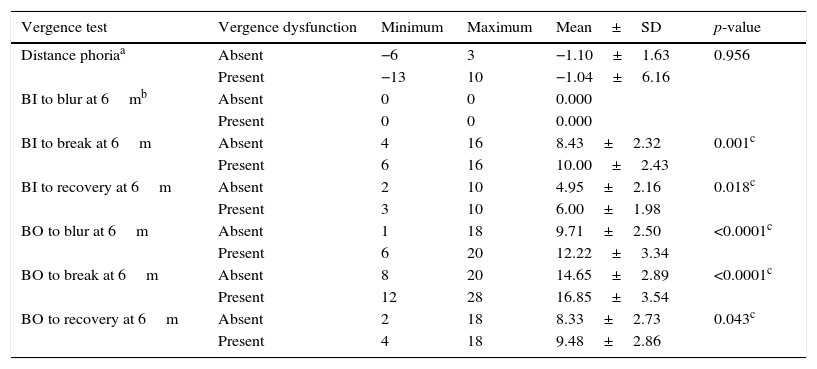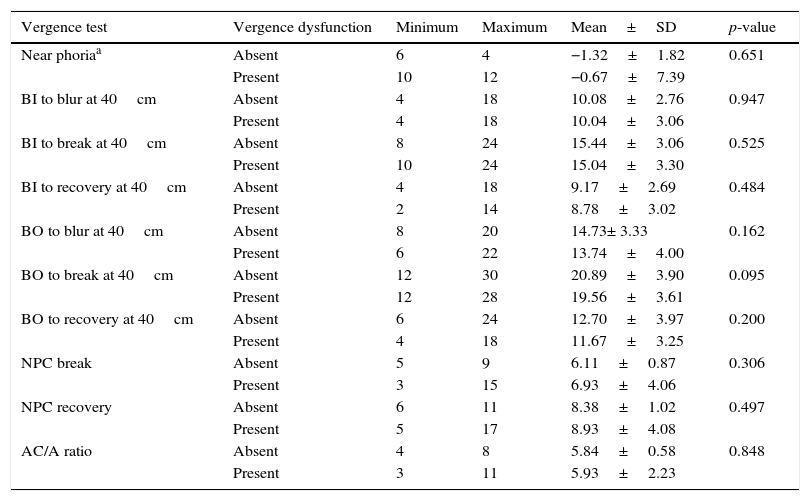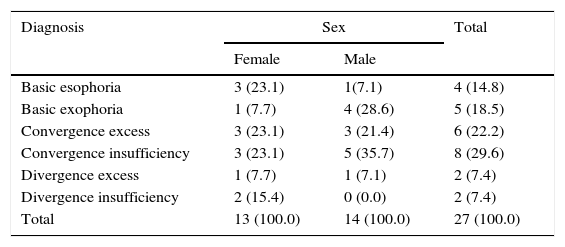The study was designed to determine the prevalence of vergence dysfunctions among first year university students in Nigeria and to document the measures that define the vergence system of the visual system.
MethodsA cross-sectional study of first year students of the University of Benin, Benin City, Nigeria, who presented for the mandatory eye examination as part of their medical examinations required for clearance was conducted. A battery of tests that defines the vergence system including near and far phoria, positive and negative fusional vergence amplitudes at far and near, near point of convergence (NPC) and AC/A ratio were measured using conventional clinical protocols.
ResultsThe prevalence of vergence dysfunction among 212 first year university students who satisfied the inclusion criteria and gave consent to participate was 12.7%, with convergence insufficiency being the most common vergence dysfunction. Blurred vision, headache and diplopia were the most frequently reported visual symptoms.
ConclusionThere is a considerable prevalence of previously undiagnosed vergence dysfunctions in this population of students. The study underscored the need to carry out a thorough binocular vision assessment as part of the battery of tests administered to newly admitted students in this community to forestall any adverse effect the presence of vergence dysfunctions might have on the academic activity of university students.
El estudio fue diseñado para determinar la prevalencia de las disfunciones de las vergencias entre los estudiantes universitarios de primer año en Nigeria, y documentar las mediciones que definen el sistema de las vergencias en el sistema visual.
MétodosSe realizó un estudio transversal de los estudiantes de primer año de la Universidad de Benin, Benin City, Nigeria, que se presentaron a un examen ocular obligatorio como parte de las pruebas médicas requeridas a efectos de certificación. Se realizaron las mediciones necesarias para caracterizar el sistema de vergencias, incluyendo foria cercana y lejana, amplitudes de las vergencias fusionales positiva y negativa cercanas y lejanas, punto próximo de convergencia (NPC) y ratio AC/A, utilizando protocolos clínicos convencionales.
ResultadosLa prevalencia de las disfunciones de la vergencia entre los 212 estudiantes universitarios de primer año que satisficieron los criterios de inclusión, y prestaron su consentimiento a participar, fue del 12.7%, siendo la insuficiencia de la convergencia la disfunción de las vergencias más común. Los síntomas visuales más frecuentemente reportados fueron visión borrosa, cefalea y diplopía.
ConclusiónExiste una prevalencia considerable de disfunciones de vergencias no diagnosticadas previamente en esta población de estudiantes. El estudio subrayó la necesidad de realizar una valoración profunda de la visión binocular como parte de la serie de pruebas realizadas a los nuevos estudiantes de esta comunidad, de cara a prevenir cualquier efecto adverso que pudiera producirse sobre la actividad académica de los estudiantes universitarios como consecuencia de la presencia de disfunciones de las vergencias.
Vergence dysfunctions describe a wide range of motor disorders of the visual system and includes convergence insufficiency, convergence excess, divergence insufficiency, divergence excess, decompensated heterophoria as well as inefficient and inaccurate pursuits and saccadic eye movements.1 These binocular vision disorders are of particular significance during prolonged visual tasks such as reading. Whereas there is considerable evidence that individuals with binocular vision dysfunction experience significantly more visual symptoms associated with prolonged use of the eyes compared to those without binocular vision dysfunctions,2–4 there is however debate whether this association is important for reading performance5,6 and by extension for academic performance. Grisham et al.,4 demonstrated that there was an increase in the number of asthenopic complaints during reading compared to when not reading. They suggested that visual symptoms are a factor in reducing reading performance in symptomatic individuals.
During transition from high school to the university, there is a tendency for increased reading for considerably longer periods. This increased prolong reading might have implications for individuals who have binocular vision dysfunctions. Porcar and Martinez-Palomera7 have reported that accommodative and non-strabismic binocular vision problems are prevalent in this population with a prevalence reported to be as much as 32.3% among university students.
Several studies8–13 have reported the prevalence of these dysfunctions in the general population and specific populations. These studies reported varying prevalence of both accommodative and vergence dysfunctions. The wide range of prevalence reported could be attributed to the different criteria used in the diagnosis of the various dysfunctions by the different authors as well as the differences in the study populations.
Whereas the prevalence of these dysfunctions is widely reported for Caucasian populations,7,9–11,13 we did not find any report for Nigerian populations. The paucity of data on the prevalence of binocular vision dysfunction in this part of the world may be related to the fact that the practice of optometry and the development of subspecialty in pediatric optometry is relatively new. It could also be due to the fact that primary eye care professionals rarely examine patients with a view to diagnosing vergence dysfunctions. As noted by Maino,8 “as primary eye care professionals we do not ask the right case history questions; we do not evaluate patients using the right tests; we do not make the diagnosis; and we do not treat or refer out for treatment these frequently encountered but often ignored disorders”.
The present study was therefore designed to provide a preliminary data on the prevalence of vergence dysfunctions as well as document vergence findings among first year university students at the University of Benin, Benin City, Nigeria. A comparison between symptomatic and asymptomatic subjects is also reported.
MethodsA proposal to conduct the study was presented to the University of Benin and approval was obtained from the research committee of the Department of Optometry, University of Benin. First year students presenting for their medical and eye examinations were invited to participate in the study. Since the study was an exploratory study, all first year students admitted into the University of Benin in the 2012/13 academic year were eligible for the study. The purpose of the additional tests to be performed in addition to the battery of tests approved for the mandatory eye examination were communicated to volunteers who gave consent to participate in the study.
The examination procedure included a detailed case history with questionnaires for patient to report any visual symptoms they may have experienced especially when reading. Other clinical tests include visual acuity at distance and near, ocular health examination, subjective refraction, cover test, near point of convergence (NPC), distance and near phoria using von Graefe technique, positive and negative fusional vergence tests at distance and near as well as the accommodative convergence–accommodation ratio (AC/A ratio). The diagnosis of basic exophoria, basic esophoria, convergence excess, convergence insufficiency, divergence excess and divergence insufficiency in this study was based on the characteristics shown in Table 1.
Diagnostic characteristics employed in the study.
| Diagnosisa | Characteristicsb |
|---|---|
| Basic exophoria | High exophoria, of the same magnitude at far and near |
| Basic esophoria | High esophoria of the same magnitude at far and near |
| Convergence excess | High esophoria, near>far, low NPC, high AC/A ratio (≥7) |
| Convergence insufficiency | High exophoria, near>far, receded NPC, low AC/A ratio (≤4) |
| Divergence excess | High exophoria, far>near |
| Divergence insufficiency | High esophoria, far>near |
Data analysis was performed using SPSS version 21. Appropriate descriptive statistics were used to summarize the data obtained.
A total of 212 first year university students participated in the study. This comprised of 104 (49.1%) males and 108 (50.9%) females aged 15–28 years. The mean age of the subjects was 18.5±2.2 years (95% Confidence Interval=18.2–18.8 years). The mean age of the male subjects was 18.5±2.3 years (95% Confidence Interval=18.1–18.9 years) while that of the female subjects was 18.5±2.0 years (95% Confidence Interval=18.1–18.9 years). There was no significant difference between the ages of the male and female subjects (p=0.977). Table 2 shows the age distribution of the study subjects. There was no significant relationship between the subjects’ age and their gender (χ2=0.428, p=0.807).
Vergence findingsThe phoria, vergence, NPC and AC/A results of the subjects are shown in Table 2. The mean distance phoria for the subjects was −1.10±1.63Δ (that is 1.10Δ exophoria) with a range of 6Δ exophoria to 3Δ esophoria for those without vergence dysfunction while for those with vergence dysfunction, the mean distance phoria was −1.04±6.16 (that is 1.04Δ exophoria). The range was between 13Δ exophoria to 10Δ esophoria for eyes with vergence dysfunction. Notwithstanding, there was no significant difference between the mean distance phoria for those who were diagnosed of vergence dysfunction and those without vergence dysfunction. Those with vergence dysfunction show a wide variation in the distance phoria. For near phoria, the mean was −1.32±1.82Δ with a range from 6Δ exophoria to 4Δ esophoria for those without vergence dysfunction and −0.67±7.39Δ and a range from 10Δ exophoria to 12Δ esophoria for those with vergence dysfunction. The mean NPC break and recovery was 6.11±0.87cm and 8.38±1.02cm respectively for those without vergence dysfunction, whereas for those with vergence dysfunction the respective values were 6.93±4.06 and 8.93±4.08cm. The mean base in to blur/break/recovery at distance was x/8.43/4.95 (SD=x/2.32/2.16) for those without vergence dysfunction, while for those with vergence dysfunction the values were x/10/6 (SD=x/2.43/1.96). Similarly, the mean base out to blur/break/recovery at distance was 9.71/14.65/8.33 (SD=2.50/2.89/2.73) for those without vergence dysfunction while for those with vergence dysfunction the mean values were 12.22/16.85/9.48 (SD=3.34/3.54/2.86).
There was no significant difference between the values obtained in those with vergence dysfunctions and those without vergence dysfunctions for the measured variables except the positive and negative fusional vergence findings at distance (see Table 3).
Phoria, fusional vergence at 6m of study subjects.
| Vergence test | Vergence dysfunction | Minimum | Maximum | Mean±SD | p-value |
|---|---|---|---|---|---|
| Distance phoriaa | Absent | −6 | 3 | −1.10±1.63 | 0.956 |
| Present | −13 | 10 | −1.04±6.16 | ||
| BI to blur at 6mb | Absent | 0 | 0 | 0.000 | |
| Present | 0 | 0 | 0.000 | ||
| BI to break at 6m | Absent | 4 | 16 | 8.43±2.32 | 0.001c |
| Present | 6 | 16 | 10.00±2.43 | ||
| BI to recovery at 6m | Absent | 2 | 10 | 4.95±2.16 | 0.018c |
| Present | 3 | 10 | 6.00±1.98 | ||
| BO to blur at 6m | Absent | 1 | 18 | 9.71±2.50 | <0.0001c |
| Present | 6 | 20 | 12.22±3.34 | ||
| BO to break at 6m | Absent | 8 | 20 | 14.65±2.89 | <0.0001c |
| Present | 12 | 28 | 16.85±3.54 | ||
| BO to recovery at 6m | Absent | 2 | 18 | 8.33±2.73 | 0.043c |
| Present | 4 | 18 | 9.48±2.86 |
Phoria, fusional vergence, NPC and AC/A ratio at 40cm of study subjects.
| Vergence test | Vergence dysfunction | Minimum | Maximum | Mean±SD | p-value |
|---|---|---|---|---|---|
| Near phoriaa | Absent | 6 | 4 | −1.32±1.82 | 0.651 |
| Present | 10 | 12 | −0.67±7.39 | ||
| BI to blur at 40cm | Absent | 4 | 18 | 10.08±2.76 | 0.947 |
| Present | 4 | 18 | 10.04±3.06 | ||
| BI to break at 40cm | Absent | 8 | 24 | 15.44±3.06 | 0.525 |
| Present | 10 | 24 | 15.04±3.30 | ||
| BI to recovery at 40cm | Absent | 4 | 18 | 9.17±2.69 | 0.484 |
| Present | 2 | 14 | 8.78±3.02 | ||
| BO to blur at 40cm | Absent | 8 | 20 | 14.73± 3.33 | 0.162 |
| Present | 6 | 22 | 13.74±4.00 | ||
| BO to break at 40cm | Absent | 12 | 30 | 20.89±3.90 | 0.095 |
| Present | 12 | 28 | 19.56±3.61 | ||
| BO to recovery at 40cm | Absent | 6 | 24 | 12.70±3.97 | 0.200 |
| Present | 4 | 18 | 11.67±3.25 | ||
| NPC break | Absent | 5 | 9 | 6.11±0.87 | 0.306 |
| Present | 3 | 15 | 6.93±4.06 | ||
| NPC recovery | Absent | 6 | 11 | 8.38±1.02 | 0.497 |
| Present | 5 | 17 | 8.93±4.08 | ||
| AC/A ratio | Absent | 4 | 8 | 5.84±0.58 | 0.848 |
| Present | 3 | 11 | 5.93±2.23 |
Of the total 212 subjects, 27 (12.7%) had vergence anomaly while 185 (87.3%) did not have vergence anomaly. Thus, the prevalence of vergence anomalies among first year university students in Benin City, Nigeria was 12.7%. This comprised of 14 (51.86%) male and 13 (48.14%) female subjects (Odds Ratio=1.137, 95% Confidence Interval=0.507–2.550). Convergence insufficiency was the most common vergence anomaly found in the study followed by convergence excess (Table 4). The type of vergence dysfunction suffered by the subjects was independent of the sex of the study participants (Fisher's Exact Test=5.00, p=0.464).
Distribution of vergence anomalies among the study subjects.
| Diagnosis | Sex | Total | |
|---|---|---|---|
| Female | Male | ||
| Basic esophoria | 3 (23.1) | 1(7.1) | 4 (14.8) |
| Basic exophoria | 1 (7.7) | 4 (28.6) | 5 (18.5) |
| Convergence excess | 3 (23.1) | 3 (21.4) | 6 (22.2) |
| Convergence insufficiency | 3 (23.1) | 5 (35.7) | 8 (29.6) |
| Divergence excess | 1 (7.7) | 1 (7.1) | 2 (7.4) |
| Divergence insufficiency | 2 (15.4) | 0 (0.0) | 2 (7.4) |
| Total | 13 (100.0) | 14 (100.0) | 27 (100.0) |
(Fisher's Exact Test=5.00, p=0.464).
In terms of age, 13 (48.1%) had vergence dysfunction within the 19–22 years age group followed by 9 (33.3%) in the age group 23–26 years and 5 (18.6%) in the age group 15–18 years (Figure 1).
The subjects who had vergence anomalies reported various symptoms including intermittent diplopia, headache, transient blur vision, etc. (Figure 2).
Discussion and conclusionThe present study documents the mean and range of values for vergence tests for a population of first year Nigerian University students aged 15–28 years. It was difficult to compare the values obtained in this study with previously documented findings because of the differences in the age of subjects, sample size and population studied. Notwithstanding, cut-off for the break finding for the near point of convergence (NPC) would appear to be about 6cm. This is similar to the value suggested as a clinical cut-off for NPC break for patients in elementary school.14 The authors remarked that using this cut-off for the general population may lead to high false-positive rates. A cut-off of 5cm has been suggested by Maples and Hoenes.15 In the present study, symptomatic subjects had higher NPC break with a large variation compared to asymptomatic subjects though this difference was not statistically significant. Of all the measured variables, only the positive and negative fusional vergence amplitudes at far were significantly different for both symptomatic and asymptomatic subjects. It will also be noted that there were subjects with vergence dysfunction that reached a fusional vergence break of 16Δ. While this may be theoretically implausible, it does reflect the fact that the presence of vergence anomaly is not only related to the magnitude of an individual finding with respect to decompensated phoria but also to the level of balance between the fusional vergence reserve relative to the phoria demand1,16 (1; 2). This abnormally high value of 16Δ may represent a normal variation in the general population. The mean value of the fusional vergence break however is reflective of the expected normative findings.
The lack of difference between subjects with and without vergence dysfunctions may reflect the fact that no one single diagnostic criteria is sufficient in adequately classifying subjects who have vergence anomaly. It may also be indicative of the fact that vergence dysfunction occurs more frequently as a syndrome where more than one clinical entity coexist in eliciting symptoms. For example, convergence insufficiency often coexists with accommodative insufficiency and the later has been found to be the primary source of symptoms when both conditions coexist.17 The implication therefore is that in evaluating a patient with symptoms suggestive of binocular vision anomaly, both the vergence and accommodative systems should be thoroughly reviewed.
The prevalence of vergence dysfunctions amongst first year university students of a Nigerian University was 12.7% with almost equal prevalence in male and female subjects. Convergence insufficiency was the most common vergence finding followed by convergence excess and basic exophoria.
Most literature surveyed on the prevalence of vergence dysfunctions reported the total prevalence of accommodative and vergence dysfunctions together.7,9–11,13,17,18 The prevalence of convergence insufficiency in this study was 29.6%. This is much lower compared to 61.4% reported by Duam18 but more than values reported by other authors.7,9–11,13,17,19 The wide range of prevalence of convergence insufficiency and other vergence dysfunctions reported in the literature reflects the variation in the diagnostic criteria employed, the sample size as well as the population studied – whether they are clinic population, general population or a population of students. It is also influenced by the age group studied, depending if it is a population of children or adults.
Diplopia and headache were the most frequently reported symptoms by subjects diagnosed with vergence dysfunction in the present study. In addition to blur vision, these accounted for 86% of patients’ complaints. This is higher compared to 38.5% reported by Porcar and Palomera7 and 33.8% reported by Montes-Mico.11 These symptoms may have serious implications for academic activities by university students. They are capable of preventing the student from studying for long period of time. A limitation in this study in respect of the report of headache as a symptom is the fact that no further history were undertaken to rule out other causes of headache. However, since the question posed to the respondents was that they should report the symptoms they have during reading, one could assume that these symptoms were related to the use of the eyes. Similarly, the report of diplopia in the present study may present some limitations. Besides vergence anomalies, other motor anomalies of the visual system could cause diplopia. These causes were not evaluated in the present study.
Curiously, none of the symptomatic subjects in this study have presented for an eye examination prior to this study. When asked what action they took when these symptoms of binocular anomalies arose, majority of the subject claimed to take a break from their studies to relax the eyes. Some often dismiss the symptoms as being due to other stressful activities such as going from one lecture venue to the other.
In conclusion, the study finds a considerable prevalence of previously undiagnosed vergence anomalies, with convergence insufficiency being the predominant anomaly. The symptoms reported have the potential to affect academic activities of the students. The findings suggest that a thorough eye examination to detect binocular vision anomalies should be administered to university students in order to promote an efficient visual system for adequate educational activities.
Conflicts of interestThe authors have no conflicts of interest to declare.

















